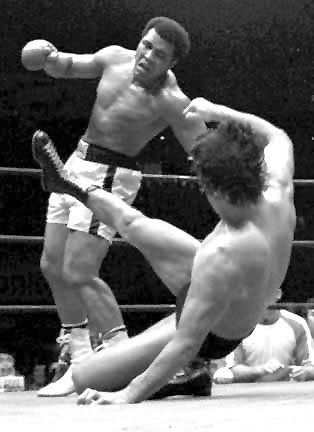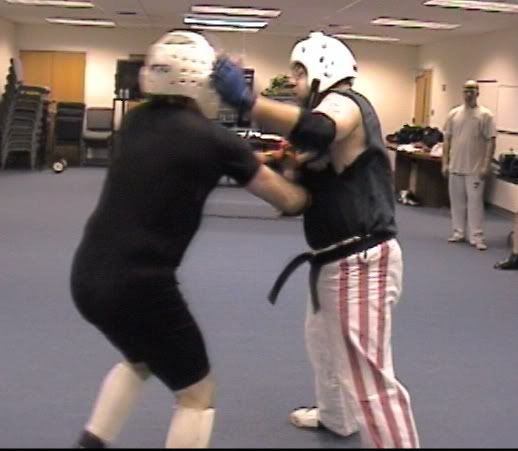
Boxing is one of my base arts because (no particular order):
- It has a "flow." Intrinsic to this art and "sweet science," is a smooth integration of offence and defense, with built in combinations coming from the position one technique ends in flowing into another technique, and so on
- Boxing training teaches one to take a hit and deliver one back, because you can practice all the legal techniques safely with some control and do no harm to your partner
- It smoothly integrates with other systems and styles, as seen in muay Thai, American Full-Contact, and MMA (including all hybrid sport styles), and has even changed point fighting
- It's effective - boxing techniques generate the most power out of hand techniques, with the possible exception of the spinning backfist
- Every martial artist must learn to defend against boxing punches, so most instructors who teach self-defense or "reality" fighting have to know it to some degree
Boxing in MMA: Boxing seems to form the basis for standup striking with the hands for all MMA fighters that I've seen. Its basic punches (jab, straight/cross, hook, and uppercuts), plus elbows have formed the basis for the upper-body arsenal. I like it, it's effective, and most striking KOs in MMA seem to come from boxing techniques. With the addition of the little 4-Oz. MMA gloves, gone are the open-hand strikes that were a mainstay in the early days. Striking is now encouraged by the rules, and even the better grapplers must know it, know how to defend it, and are using it to create openings for takedowns. Where I have a problem with MMA fighters use of boxing is in two areas:
- The jab is almost a forgotten punch. The jab is designed to lead, stop-hit (intercept and counter) a curved strike, as a range-finder, and disrupt an opponent's offensive rhythm. It's been replaced by rear-hand leads haymakers and overhands, which look cool, but are an open invitation to get countered. More jabbing would get fighters in to do damage safely. I may never have stepped into a cage, but I've watched and participated in fighting of one form or another for over thirty years, and I can tell you that more jabbing will make most of these fighters and fights better.
- The open or "peek-a-boo"-style guard is nearly universal. I will post with pictures on this later, but see this (and this) post on why we get hit for a good reason - poor opposition to what can hit you. When you are standing up and away from your opponent, use a guard that puts your hands in the way of straight punches; force your opponent to work for an opening by keeping something in the way. The peek-a-boo works for boxers because they also use constant side-to-side movement of the head (see an early Mike Tyson for a good example), and dip to avoid straight shots. MMA fighters have to worry about leg kicks, surprise head kicks, but also blasting straight punches. Keeping the hands up and out in front will take care of that. When you get inside, that open guard position is perfect for stopping hooks and elbows.
 due to fear of injury, and that the fear of injuring your hands is well-founded. When adapting boxing for self-defense you need to:
due to fear of injury, and that the fear of injuring your hands is well-founded. When adapting boxing for self-defense you need to:- Modify all techniques aimed at the hard parts of the head to be palm or hammerfists to avoid injury. Much has been written on this (by me, and many, many others), but hitting something hard with your fist isn't smart. In a real fight for your life it could be suicidal as your hand may be disabled, and the pain may distract you long enough to get killed. The jab should morph into an eye jab or lead-hand palm to the nose, chin or forehead. Open hand strikes (like a hook, but with an open hand) should replace hooks and overhands.
- Boxing techniques to the body are excellent, except the body jab, straight, or cross. To perform any of those properly, you have to get your shoulder level with the target. That will put your head in perfect position to accept a knee to the face. Stick to uppercuts to the groin, bladder, solar plexus and kidneys. Hooks are the same, but may also be used to the side of the neck with great effectiveness.
- Defensively, slipping and parrying, are great, but ducking is a no-no. It will get you flattened by a knee.Add in bumping with the shoulders and hips, and checking or grabbing with your hands. Traps are also possible now.
See previous posts related to this:
Making the transition from boxing to MMA gloves
If it's against the rules, then it must work!
Why are martial sports superior?
What is an effective lead?
____
Interact with us at our TDA Training Facebook page!
All rights reserved. Permission must be obtained before use. Copyright 2006

11 comments:
Right!
Well said, Anonymous!
Nathan. Great post. I'm not sure that I agree that the jab is forgotten in MMA. Some fighters, say Chuck Liddell, tend to rely on his deadly right on his left hook. But there are many, especially in the lighter weight classes, whose jabbing is constant.
my trainer always says practice practice on your jab he trained over 50 years ...
I like your advice on never ducking or trying to go for straight punches to the body: if you're up against a kick or thaiboxer you will end up eating a knee, especially when you have the audacity of trying it twice. Bobbing&weaving is still a valid tactic against a hook, aslong as you weave towards him, stepping in while you do so. If you end up more or less to his side a knee is out of the question, if you do it wrong and stay in front of him he'll still be able to nail you.
I fully agree with you on your list of reasons why boxing is a great art: what I love about boxing is the power it generates while offering maximum protecting and optimum mobility. As you said it flows (nice, crisp combinations while constantly moving and defending/covering) and is so much more effective than the all or nothing, sawing-type forward punches practiced in karate. As you said it also integrates easily into other systems/arts, both for sport or self-defense purposes, and when you add some dirty tactics and some grappling you have a very potent, tough and easy to learn fighting system.
For the street boxing needs to be modified though: fighting with gloved fists and bare hands are two completely different things, in defense it wouldn't make much sense to catch a punch on your hand as you would on the glove, plus standard boxing-gloves are like little shields you can hide behind. Still the basics apply and a good boxer will be hard to beat in almost any circumstances.
Great post!
Zara
BOXING PUCHES AND MUAY THAI PUNCHES ARE DIFFERENT FOR THERE VERY OWN GOOD REASONS..
A THAI FIGHTER HAS TO DECIEDE INSTANTLY IF I WANTS TO TWIST HIS LEGS OR USE THE SAME LEG TO KICK..
A THAI FIGHTER WOULD RATHER EXECUTE A LURCHING PUNCH THAN TWIST AT ALL..
THERE IS DIFFERENT GOAL AND MOTTIFS TO ATTEND TO IN THAI FIGHITNG..
THOUGH BOTH BOXING AND MUAY THAI USE PUNCHES THERE IS A DIFFERENT STRETEGY AND IMPLIMENTATION OF THE PUNCHES..
JUST LET THAT LITTEL THAI FIGHTER GIVE YOU A TAP AND YOU BE THE JUDGE IF THERE IS POWER IN THERE HANDS!!
Great post and discussion Nathan. I am a firm believer in boxing for self defence. A good crisp jab is sometimes all it takes to convey the message "Don't mess with this rattlesnake, there is easier prey in the meadow", without having to pull out the firepower.
Ducking can still be a valid technique, provided the elbows are kept in and the head is up so you can see the strikes or kicks coming in, although like you say, it can be risky. I particularly like how you can incorporate bobbing and weaving with strikes at the same time. An evasion and attack at the simulaneously, .....beauty.
This is so interesting blog. You are best listing knowledge provide at this site. I am very excited read this nice article. You can visit my website.
boxing ring
Good point about using open palms when striking. You're no good with a busted up hand. In Krav Maga, we train open palm strikes as well as using your fist so you get used to doing the techniques that way.
Thanks for the great post.
Very well said. MMA trainings on boxing are indeed have a different approach.
I've wanted to learn how to box for a really long time. I think it would be a very therapeutic sport. I actually know someone who does MMA fighting. I think it's kind of crazy to watch, and I would never compete myself. I would just learn how to box for fun.
Claudia Rosenburg | http://www.bancroftboxing.com
Post a Comment